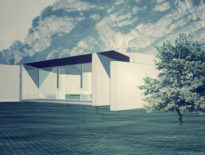
Seattle Mayor Ed Murray with Amanda Sturgeon, Denis Hayes and others at the legislation signing of the LBCPP.
On Friday, October 7th, Mayor Ed Murray signed legislation to continue the Living Building Pilot Program until 2025. The updated Living Building program legislation expands on a pilot program started in 2009 and increases the number of buildings that can participate to 20. There are new provisions and adjustments in the legislation that align better with city and state laws, as well as streamline building codes to incentivize developers on adopting regenerative building practices.
The Living Building Pilot Program (LBPP) applies to existing and new construction projects that pursue the Living Building Challenge—the world’s most rigorous sustainable building program. The Living Building Challenge calls for the creation of building projects at all scales that operate as cleanly, beautifully and efficiently as nature’s architecture – projects that generate all of their own energy with renewable resources, that capture and treat all of their water, and operate efficiently with maximum beauty and addressing equity.
The legislation incorporates updates from the LBPP Technical Advisory Group (TAG) that met for over a year to recommend adjustments that maintain the rigor of the program while incentivizing Living Buildings. Incentives including a 15% increase in floor area ratio (FAR) and a height increase incorporating 10’ in zones with height limits of 85’ or less and 20’ in zones with height limits greater than 85’.
Additional changes include updates to the two City requirements for projects that decide to pursue the Petal Certification pathway: energy use must be 75% or less of targets established in the energy code, and potable water cannot be used for non-potable uses. With the new legislation, these incentives are now granted outright for developers participating in the LBPP which provides more certainty for project teams, in lieu of the previous system that allowed similar departures achieved through the design review process.
“The Living Building Pilot Program is an important tool to encourage developers who are transforming our City to construct to the built environment’s most rigorous performance standard – The Living Building Challenge – while meeting important implementation targets outlined in the 2013 Seattle Climate Action Plan,” said Amanda Sturgeon, CEO of the International Living Future Institute.
The new adjustments to the LBPP are important to Seattle as a leader in green building and are critical in meeting the City’s climate action goals. Currently, Seattle has two certified Living Buildings, the Bullitt Center and the Bertschi Living Building Science Wing. As construction skyrockets in Seattle, it is crucial that new and existing buildings adopt regenerative building practices and the Living Building Pilot Program intends to further that.
The City of Cincinnati and the City of Miami Beach have also incorporated the Living Building Challenge into legislation.


